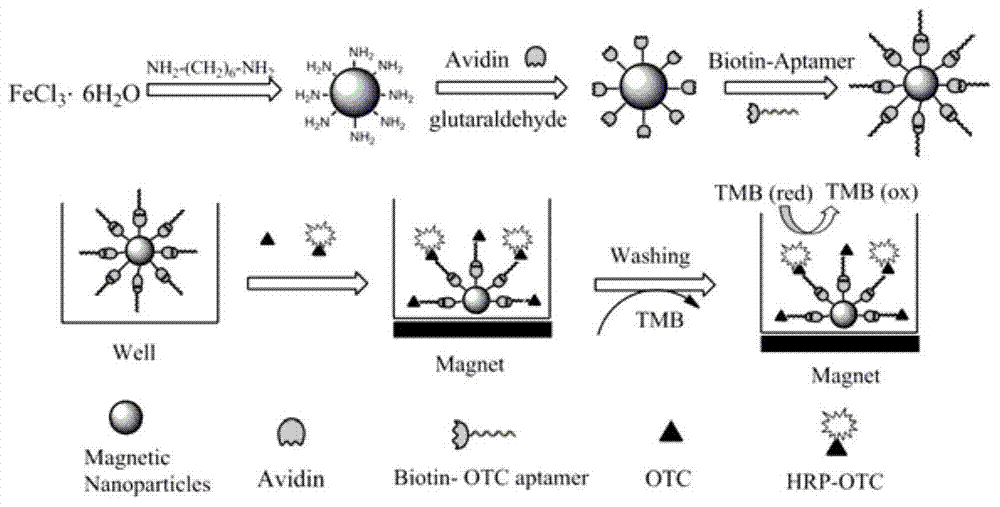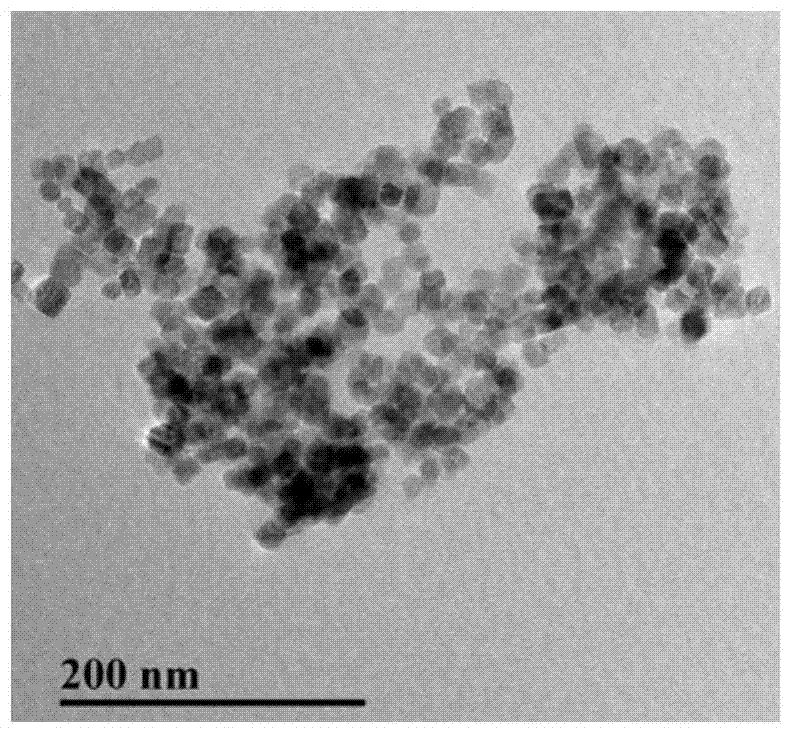A method for functionalized magnetic bead separation-enzyme-linked aptamer detection of oxytetracycline in food
An enzyme-linked aptamer and magnetic bead separation technology, applied in the direction of color/spectral characteristic measurement, etc., can solve the problem that the electrochemical signal of the sample matrix is easy to cause interference, cannot meet the needs of oxytetracycline detection, and the aptamer immobilization step consumes a lot of time. Time and other issues, to achieve the effect of reducing detection cost, improving specificity, and low detection cost
- Summary
- Abstract
- Description
- Claims
- Application Information
AI Technical Summary
Problems solved by technology
Method used
Image
Examples
Embodiment 1
[0041] Embodiment 1: Determination of milk samples
[0042] 1. Preparation of nucleic acid aptamer-magnetic nanoparticle complex probe
[0043] The preparation of the nucleic acid aptamer-magnetic nanoparticle complex probe was prepared by the method reported in the literature (Wu SJ, Duan N, Wang ZP, et al. Analyst, 2011, 136, 2306-2314).
[0044] 1. Preparation of aminated nano-magnetic beads: Add 6.5 g of 1,6-hexanediamine, 2.0 g of anhydrous sodium acetate (CH 3 COONa) and 1.0 g ferric chloride hexahydrate (FeCl 3 ·6H 2 O), stirred at 50°C to obtain a colloidal solution, and transferred the solution to a 50mL reactor lined with polytetrafluoroethylene, and reacted at 198°C for 6h. Cool to room temperature, discard the upper liquid, wash out the lower solid material with deionized water, and collect it by magnetic separation. Wash twice with deionized water and ethanol respectively, and dry at 50°C for 5-10h. Scanning electron microscope images of aminated nano-magneti...
Embodiment 2
[0056] Embodiment 2: Determination of animal tissue samples
[0057] Method is the same as embodiment one, difference is the pretreatment method of sample:
[0058] Weigh 1.0 g of chicken sample into a 50 mL centrifuge tube, add 4 mL of extraction solution, vortex mix for 10 min, and centrifuge at 15000 r / min for 10 min. Take 200uL of the supernatant and dilute to 1 mL with 10mmol / L PBS buffer for analysis. Substitute into the standard curve to calculate the content of oxytetracycline in the sample.
Embodiment 3
[0059] Embodiment 3: honey sample determination
[0060] Method is the same as embodiment one, difference is the pretreatment method of sample:
[0061] Accurately weigh 1.0g honey sample into a 50mL screw cap centrifuge tube, add 10mL PBS buffer (10 mmol / L, pH 7.4), vortex for 5min, sonicate for 5min, and take 100μL of the supernatant for analysis. Calculate the content of the analyte in the sample according to the standard curve.
PUM
 Login to View More
Login to View More Abstract
Description
Claims
Application Information
 Login to View More
Login to View More - R&D
- Intellectual Property
- Life Sciences
- Materials
- Tech Scout
- Unparalleled Data Quality
- Higher Quality Content
- 60% Fewer Hallucinations
Browse by: Latest US Patents, China's latest patents, Technical Efficacy Thesaurus, Application Domain, Technology Topic, Popular Technical Reports.
© 2025 PatSnap. All rights reserved.Legal|Privacy policy|Modern Slavery Act Transparency Statement|Sitemap|About US| Contact US: help@patsnap.com



